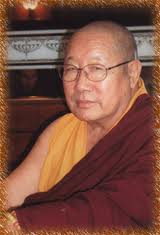The following is adapted from an oral commentary given by His Holiness in conjunction with a ceremony wherein he bestowed the bodhisattva vow upon a gathering of disciples at Namdroling in Bozeman, Montana, November 1999:
In general, dharma consists of many divisions an distinctions of spiritual teachings, while at the same time the nature of all dharma is that it has the potential to liberate beings, both temporarily and ultimately, from the suffering of cyclic existence. The main cause or seed for that [liberation] is the cultivation of bodhicitta. Various traditions exist for the bodhisattva vow ritual and training. The lineage for these particular teachings, which was passed from Nargarjuna to Shantideva, is known as the tradition of the Middle Way as well as the lineage of the bodhisattvas.
There are four aspects related to receiving the bodhisattva vow: receiving the vow itself, ensuring the vow does not degenerate, repairing the vow if it is damaged, and methods for continuing to cultivate and maintain the vow.
The first aspect of receiving the vow itself has three aspects: the individual from whom one receives the vow, oneself as a qualified recipient, and the ritual for receiving the vow.
First, the individual from whom one receives the vow must have strong faith in the Mahayana vehicle and must be a true upholder of the vow. He or she must be someone within whom the vow abides and should also be someone who is very learned concerning the vehicles, particularly concerning bodhisattva training. Such a person must never abandon bodhicitta and must always keep the vows pure, even at the cost of his or her own life. That individual must also be a practitioner of the six paramitas of generosity, morality, patience, diligence, meditation, and prajna, and must never engage in any activity that contradicts them.
According to the tradition of Nagarjuna, the way to receive the vow for the first time is from a spiritual guide. Later, if an individual’s vows degenerate, and if a spiritual guide is then absent, the person can restore the vows in the presence of an image of the buddha. It is not necessary that they be restored in the presence of a spiritual guide.
The second aspect for receiving the vow itself concerns the individual who qualifies to receive it.
According to the tradition of Nagarjuna, all sentient beings who desire to receive the bodhisattva vow qualify to receive it. The only exception is types of gods in the formless realm, called gods devoid of recognition, which are gods that lack cognitive abilities. With this one exception, basically all sentient beings qualify to receive the vow. But those who qualify in particular are those who have supreme knowledge, which refers to those who know what the bodhisattva vow is and what the benefits of receiving and maintaining it are. Such individuals are particularly worthy recipients because they have profound compassion and are able to use that compassion to bring both temporal and ultimate benefit to other beings. In short, any individual who has an altruistic attitude and wishes to take the bodhisattva vow qualifies to receive it.
The ritual [which is the third aspect of receiving the vow itself] also has three parts: the preliminaries, the actual ritual, and the concluding dedication. The preliminaries have four parts: adjusting one’s own intention, supplicating the objects that confer the vow, taking the support of refuge, and practicing the method for accumulating merit.












OM TARE TUTTARE TURE SOJA